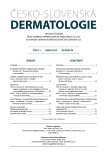-
Medical journals
- Career
Acarodermatitis – Dermatitis Caused by Mites
Authors: L. Drlík 1; L. Pock 2; C. Babička 3
Authors‘ workplace: Dermatovenerologické oddělení, Šumperská nemocnice, a. s., primář oddělení MUDr. Lubomír Drlík 1; Bioptická laboratoř s. r. o., Plzeň, odborná vedoucí lékařka prof. MUDr. Alena Skálová, CSc. 2; Parazitologické oddělení, Okresní hygienická stanice Šumperk, vedoucí pracoviště RNDr. Ctirad Babička, CSc. 3
Published in: Čes-slov Derm, 90, 2015, No. 1, p. 25-33
Category: Case interpretation
Overview
Acarodermatitis is a very common disease in clinical practice. It affects, especially, patients running their own farm. It also occurs in city inhabitants keeping pets – dogs, cats, guinea pigs or rabbits. The pets may be affected by cheyletiella. Acarodermatitis represents a remarkable interdisciplinary topic for dermatologists, veterinarians and parasitologists. Contact points are also found in dermatohistopathology. Above all, cheyletiellosis cutaneous symptoms may clinically and histopathologically imitate immunobullous dermatoses.
Key words:
acarodermatitis – Cheyletiella – histological findings
Sources
1. ANSARIN, H., JALALI, M. H., MAZLOOMI, S. et. al. Scabies presenting with bullous pemphigoid-like lesions. Dermatol. Online J., 2006, 27, 12, 1, p. 19.
2. AYDINGÖZY, I. E., MANSUR, A. T. Canine scabies in humans: a case report and review of the literature. Dermatology, 2011, 223, 2, p. 104–106.
3. BABIČKA, C., DRLÍK, L., BLÁHOVÁ, I., KUBÍN, J. Akarodermatitida – onemocnění způsobené roztoči. Čes.-slov. Derm., 2001, 76, 6, p. 287–291.
4. BALIGHI, K., ROBATI, R. M., HEJAZI, N. A dilemma: bullous-pemphigoid-like eruption in scabies or scabies-induced bullous pemphigoid. Dermatol. Online J., 2006, 30, 12, 4, p. 13.
5. BARDACH, H. Acariasis due to dermanyssus gallinae (gamosoidosis) in Vienna (author‘s transl). Zeit. Hautkr., 1981, 56, 1, p. 21–26.
6. BELLANGER, A. P., BORIES, C., FOULET, F. et al. Nosocomial dermatitis caused by Dermanyssus gallinae. Infect. Control. Hosp. Epidemiol., 2008, 29, 3, p. 282–283.
7. BOLOGNIA, J. L., JORIZZO, J. L., RAPINI, R. P. Dermatology. Mosby Elsevier, 2008, p. 1311–1312. ISBN 978-1-4160-2999-1.
8. BORNHÖVD, E., PARTSCHT, K., FLAIG, M. J. et al. Bullous scabies and scabies triggered bullous pemphigoid. Hautarzt, 2001, 52, 1, p. 56–61.
9. BRAR, B. K., PALL, A., GUPTA, R. R. Bullous scabies mimicking bullous pemphigoid. J. Dermatol., 2003, 30, 9, p. 694–696.
10. BURGDORF, W. H. C., PLEWIG, G., WOLF, H. H., LANDTHALER, M. Braun-Falco´s Dermatology. Braun-Falco, O. (Editor Emeritus), Springer, 2009, p. 338–339, ISBN 978-3-540-29312-5
11. BURNS, T., BREATHNACH, S., COX, N., GRIFFITHS, C. Rook´s Textbook of Dermatology. Wiley-Blackwell, 2012, 2, p. 38.1–38.61, ISBN 978-1-4051-6169-5.
12. COHEN, S. R. Cheyletiella dermatitis. A mite infestation of rabbit, cat, dog, and man. Arch. Dermatol., 1980, 116, 4, p. 435–437.
13. COLLGROS, H., IGLESIAS-SANCHO, M., ALDUNCE, M. J. et al. Dermanyssus gallinae (chicken mite): an underdiagnosed environmental infestation. Clin. Exp. Dermatol., 2013, 38, 4, p. 374–377.
14. DOGRAMACI, A. C., CULHA, G., OZCELIK, S. Dermanyssus gallinae infestation: an unusual cause of scalp pruritus treated with permethrin shampoo. J. Dermatolog. Treat., 2010, 21, 5, p. 319–321.
15. FAIN, A., SCHEEPERS, L., DE GROOT, W. Long-lasting pruriginous dermatitis in a woman caused by an acarian dog parasite, Cheyletiella yasguri Smiley. Rev. Med. Liege, 1982, 37, 18, p. 623–625
16. GALVANY ROSSELL, L., SALLERAS REDONNET, M., UMBERT MILLET, P. Bullous scabies responding to ivermectin therapy. Actas Dermosifiliogr., 2010, 101, 1, p. 81–84.
17. GEORGI, J. R., GEORGI, M. E. Mites. Parasitology for Veterinarians. W. B. Saunders Company, Philadelphia, 1990, p. 68–73.
18. HAUSTEIN, U. F. Bullous scabies. Dermatology, 1995, 190, 1, p. 83–84.
19. HILL, M., GORDON, R. An outbreak of dermatitis among troops in North Wales caused by rodent mites. Ann. Trop. Med. Parasitol., 1945, 39, p. 46–62.
20. JÍROVEC, O. Parasitologie pro lékaře. SZN, Praha, 1954, s. 336–341.
21. JORDAAN, H. F., DU TOI, M. J., WHITAKER, D. Comment on the work of E. Kösler: „Transitory acantholytic dermatosis (Grover’s disease) with Sarcoptes scabiei infection.“ Hautarzt, 1999, 50, 4, p. 305–306.
22. KADDU, S., MÜLLEGER, R. R., KERL, H. Grover‘s disease associated with Sarcoptes scabiei. Dermatology, 2001, 202, 3, p. 252–254.
23. KÖSTLER, E. Transitory acantholytic dermatosis (Grover‘s disease) in sarcoptic scabies infection. Hautarzt, 1997, 48, 12, p. 915–917.
24. LUCKY, A. W., SAYERS, C., ARGUS, J. D. et al. Avian mite bites acquired from a new source – pet gerbils: report of 2 cases and review of the literature. Arch. Dermatol., 2001, 137, 2, p. 167–170.
25. RIVERS, J. K., MARTIN, J., PUKAY, B. Walking dandruff and Cheyletiella dermatitis. J. Am. Acad. Dermatol., 1986, 15, 5, p. 1130–1133.
26. ROXANA, S. T., PIASERICO, S., BORDIGNON, M. et al. Bullous scabies simulating pemphigoid. J. Cutan. Med. Surg., 2011, 15, 1, p. 55–57.
27. TSIANAKAS, P., POLACK, B., PINQUILER, L. et al. Cheyletiella dermatitis: an uncommon cause of vesiculobullous eruption. Ann. Dermatol. Venereol., 2000, 127, 10, p. 826–829.
28. VAN BRONSWIJK, J. E, JANSEN, L. H., OPHOF, A. J. Invasion of a house by the dog parasite Cheyletiella yasguri (Smiley 1965), a mite causing prurigo in man. Dermatologica, 1972, 45, 5, p. 338–343.
29. WOLFF, K., GOLDSMITH, L. A., KATZ, S. I., GILCHREST, B. A., PALLER, A.S., JEFFELL, D. J. Fitzpatrick´s Dermatology in General Medicine. McGraw Hill Medical, 2008, p. 2032–2033. ISBN 978-0-07-166904-7.
30. WOZNIACKA, A., HAWRO, T., SCHWARTZ, R. A. Bullous scabies: a diagnostic challenge. Cutis, 2008, 82, 5, p. 350–352.
Labels
Dermatology & STDs Paediatric dermatology & STDs Allergology and clinical immunology General practitioner for children and adolescents
Article was published inCzech-Slovak Dermatology

2015 Issue 1
Most read in this issue- Acarodermatitis – Dermatitis Caused by Mites
- Clonal Melanocytic Naevi
- Multiple Vulgar Warts Caused by a High-Risk HPV 16 in an HIV Positive Immunodeficient Patient
- Therapeutic Education in Dermatology
Login#ADS_BOTTOM_SCRIPTS#Forgotten passwordEnter the email address that you registered with. We will send you instructions on how to set a new password.
- Career

